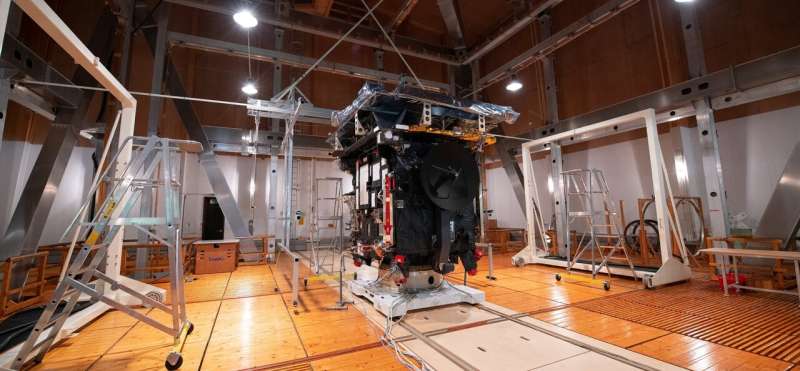Credit: ESA–S. Corvaja
As part of its testing campaign to prepare for launch, ESA's Solar Orbiter spacecraft underwent a special set of tests in a very unique location, the magnetic field simulation facility near the IABG premises in Ottobrunn, Germany.
Once in space, Solar Orbiter will perform unprecedented close-up observations of the Sun and its corona, measure the solar wind close to the Sun, and provide high-resolution images of its uncharted polar regions. These data will help us understand how our parent star creates and controls the giant bubble of plasma that surrounds the whole Solar System and influences the planets within it.
Space missions that involve measuring magnetic fields in space with exquisite accuracy—such as Solar Orbiter, which will measure the magnetic field of the solar wind, or missions studying Earth's magnetic bubble, like ESA's Cluster and Swarm—require dedicated testing to fully characterise their magnetic properties.
The magnetic field simulation facility shown in this image is located just outside the IABG premises, in a nearby forest, to avoid interference with human-generated magnetic fields. In addition to that, the facility consists completely of non-magnetic materials like wood, and contains twelve 15-m coils—nearly as large as the building—to create a homogeneous magnetic environment that compensates Earth's own magnetic field, simulating outer space conditions.
The tests were performed in June, meeting the mission requirements within the limits of the testing facility. After launch, further measurements during the commissioning phase will complement the results of these tests to fully characterise the magnetic properties of the spacecraft.
The spacecraft is currently undergoing final testing ahead of its launch, scheduled in February 2020 from Cape Canaveral in Florida, U.S.. Solar Orbiter is an ESA-led mission with strong NASA participation. The prime contractor is Airbus Defence and Space in Stevenage, UK.
Provided by European Space Agency
























